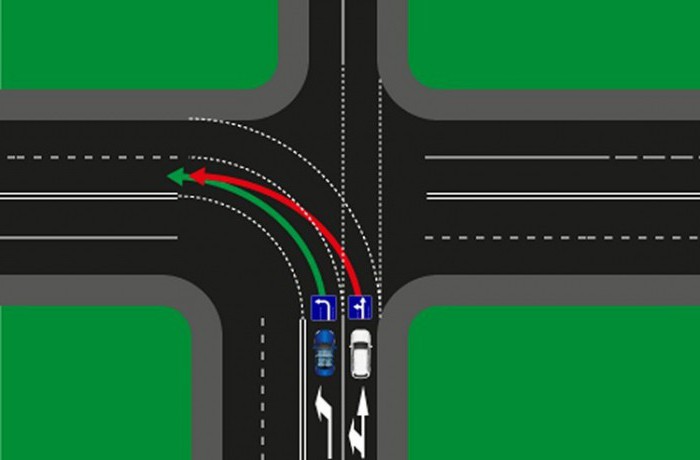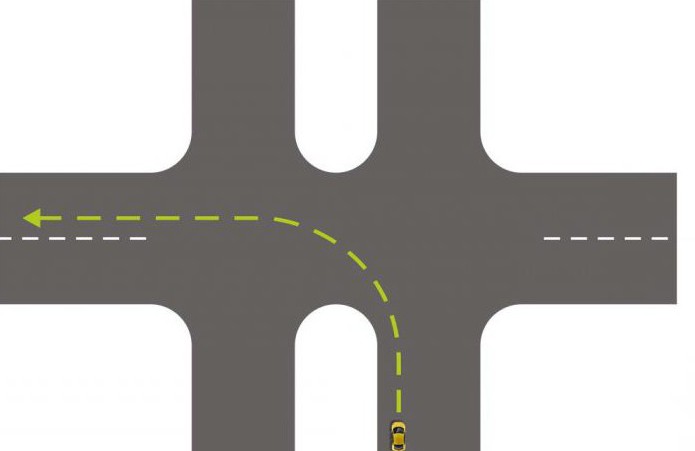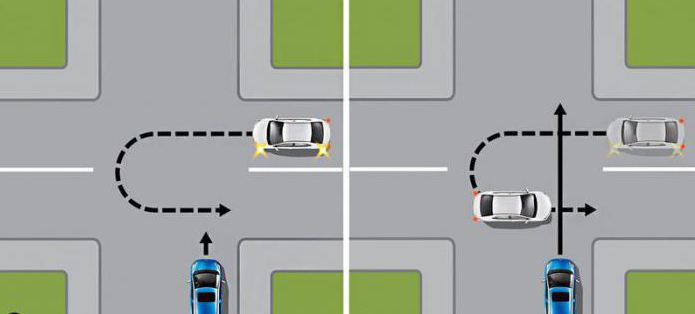Many novice drivers, setting off on their own "swimming", consider a U-turn at a one-way intersection as a serious problem for themselves. Especially if this intersection is completely unfamiliar and it has never had to turn around. Yes and experience is not enough. Indeed, a U-turn at a one-way intersection has many nuances that we’ll try to figure out.

Driver actions before starting a U-turn
According to the SDA (dated October 23, 1993, edited October 26, 2017), when performing such a maneuver as a turn (or turn) at an intersection, the driver must:
- Change lanes on the carriageway to the far left, which fully corresponds to the chosen direction.
An exception! This is not a turn at the entrance to the intersection with traffic in a circle.
- Notify all road users (UDD) of their intention by signaling. To do this, use the turn signals of the corresponding direction (or you can also use your hand). Moreover, keep in mind that the inclusion of a signal in no way gives the driver any advantages and does not exempt him from taking all kinds of precautions.

Important! Start signaling well in advance (before the start of maneuvering) and stop it as soon as the maneuver is completed. Remember! The signal should be given so clearly that it cannot mislead anyone about your intentions.
- Make sure that the maneuver does not interfere with other traffic police and does not create a dangerous situation.
If you strictly follow these and other U-turn rules at the one-way intersection, this will save you and possibly someone else.
Hand signal
Most often, motorcyclists use such signals, but no one forbids motorists (of course, if they have such an opportunity). You can serve with both hands (of course, not simultaneously, but alternately). If you want to make a left turn, then extend your left hand to the side or right, bent at a right angle in the elbow joint. If there was a need to make a right turn, then the opposite is true: either extend your right hand to the side, or your left, bent at a right angle in the elbow joint.
Important! Start signaling well in advance and finish it right before the moment the maneuver begins.
Roundabout reversal methods
Carry out (according to traffic rules) a U-turn at a one-way intersection provided that there are no signs prohibiting this maneuver. Moreover, only the driver determines the trajectory of rotation, being guided exclusively by safety. There are only two ways:
- On a small radius. Perform if the width of the roadway is not large. You need to make it at the intersection immediately after the pedestrian crossing (provided that it is available).
Important! A maneuver can only be made after the oncoming traffic stream is missed.
- Over a large radius. Perform in the presence of a fairly wide road, that is, when the driver "is where to roam." Such a maneuver is most often performed if a turn is impossible along a small radius (as a result of which you have every chance to be in the oncoming lane). That is, for various reasons (narrow road, repair work on it) there is no way to make a turn at the end of the dividing solid line.The driver has to drive a little ahead and go into the arc. As a result of all the manipulations, it turns out to integrate the vehicle in a row.

Sometimes these two methods of turning are called nothing more than a near path and a distant one. Regardless of the tricks, the rules are the same for both:
- we start the movement strictly from the near row;
- in no case do we allow intersection of markings on the road (for example, zebra or dividing line) or the edge of the roadway;
- We pay attention to the signs and characteristic features of the intersection at which we plan to carry out certain actions.
Important! No one forbids you to make a turn on a large radius where a small maneuver can be performed. If this gives you more confidence - why not?
What is a dividing strip and what is it for?
The dividing strip is a selected element (most often raised) of the roadway, which cannot be used for any movement (neither by transport, nor by pedestrians). Sometimes this part of the road is planted with green spaces, or tram traffic is organized along it.
The presence of such a lane implies the presence of two carriageways. The absence of it indicates that the road is one. Yes, there may be markings on it, but nonetheless, it continues to be a single roadway. Is it possible to make a U-turn at a one-way intersection with a dividing strip? And why not - what or who can bother you ?! The main thing is that before the intersection this dividing line is interrupted. Maneuver in accordance with traffic rules (not forgetting the signs of special requirements: 5.71 and 5.7.2) and enjoy life.
Penalties
When moving towards the intersection, do not forget that a sign (for example, 5.7.1 or 5.7.2) should be fixed in front of it, informing you about the traffic conditions in this section. If the driver violates the sign requirement, then penalties will follow.
On a note! For violation of the above signs, you can lose your rights for up to 6 months. If there are no signs, there are no violations and penalties. What could be the claim? All is fair.

U-turn details
The most important thing in such a maneuver as a U-turn at a one-way intersection is the need to perform it within the boundaries of carriageways of intersecting roads. Let's consider two options:
- The driver chooses a long trajectory and does not fit into the boundaries at all. What's happening? In this case, it inevitably crosses a solid line that delimits oncoming flows. Yes, there is no head-to-head movement. But the car moves perpendicular to the solid line. Penalties - 1,500 rubles.
- The choice was made in favor of the near path. But again the same story - you do not fit into the boundaries of the intersection. A fine of 5,000 rubles or the opportunity to say goodbye to your rights for a short period of time is only 6 months (you’ll be healthier: walking on foot is very useful), as a result of the maneuver, you go straight to the oncoming lane.
Remember! If the violation is repeated, it is unlikely to be avoided for 12 months.

Peculiarities of a U-turn depending on the “status" of the intersection
Crossroads crossroads strife. They can be adjustable and unregulated:
- Unregulated T-junction. The nuances include the fact that in this case it is strictly forbidden to carry out a backward movement, as well as to perform such a maneuver as a U-turn, in several stages. Performing all these manipulations, one should be guided by the requirements of signs from traffic rules. If they are absent, it is not a sin to remember what should be done in case of interference on the right, as well as who is following what road and who has priority in the movement. And of course, don't forget the direction indicators.
On a note! If, moving along a secondary road towards an unregulated intersection, you notice that the main traffic is too intense, then you should refuse to turn around and find another way out.
- Adjustable intersection. Some people think that in this case you can relax: the traffic light will “think” for you. But do not do this. It is better to select the leftmost position in advance; then, when the traffic light gives a green light, try to move as close as possible to the middle of the intersection; closely monitor what your motorists neighbors “get up to” to your left and rear; Skip oncoming traffic make sure that you do not interfere with anyone, and make a U-turn. Do not forget to make sure that there are no signs prohibiting such maneuvers in front of the intersection.
Attention! Be careful: a sign informing that a left turn is prohibited does not mean that a turn is also unacceptable.
U-Turn at a one-way intersection from left to right
You are moving along the road. On your way there is an intersection in front of which a sign 5.7.1 is fixed, informing you that you are traveling on the road with ML and that vehicles are moving from left to right. In addition, you are allowed to turn right. Further, it all depends on which lane you are standing in:
- If on the left, then you can follow the intersection only directly.
- If it’s on the right, then you can either make a U-turn (at the intersection with one-way traffic) to the right, or cross it (if the sign “Lane Direction” allows this).
U-turn at the right-to-left intersection
Another situation. You are moving along the roadway with markings. Swiftly approaching the intersection of roads. You intend to make a U-turn (at a one-way intersection). The sign 5.7.2 is fixed at the exit. He reminds the driver that he leaves the road with ML and that the traffic flows from right to left. In addition, the sign still gives some information. Namely, that you have every right to turn left. Therefore, in order for the U-turn at the intersection with one-way traffic on the left to be correctly completed, you need to take the left lane and finish it safely.

Reference! If you are in the right lane, you will have to follow the intersection directly, since there is no sign to turn right.
U-turn at the intersection with a pedestrian crossing
Condition - the intersection is located behind the pedestrian crossing. Your actions? Everything is very simple: a U-turn is prohibited exclusively at a pedestrian crossing, the boundaries of which are defined by markings. If it is absent (there is only a sign), then this does not mean anything. It’s also a “pedestrian crossing” in Africa (even without borders). You must skip pedestrians and make your maneuver just at the crossing, since in principle a U-turn at the intersection with one-way traffic permits. You just have to wait a bit and move forward. Then you are not afraid of any penalty.
The intersection of carriageways in two places
The question is not simple. The correctness of a U-turn at a one-way intersection with two intersections depends on the presence (or absence) of signs and on how organized the passage is on each individual section of the road.
The main thing! When performing a U-turn, be vigilant: do not find yourself in the oncoming lane.
If there are paths at the intersection and trams are moving along them, remember that the solid line marking that separates them from the carriageway is nothing more than a dividing strip.
Other useful information
- It is forbidden to call on the sidewalk, as this maneuver leads to an emergency. In addition, there is a loss of driving. It is not good.
- At intersections, it is not permitted to drive backward.

An exception! You can only engage reverse gear if you enter the courtyard of the house or if the local road is widened.
Finally
We hope that at least some light sheds on the difficult question of how to make a U-turn at a road intersection, including a U-turn at a one-way intersection with a dividing strip. How in this case to avoid the situation when you find yourself in the oncoming lane? The best way is to choose a turning path with a large radius and perform this maneuver behind the center of the intersection. Then everything should work out as it should.